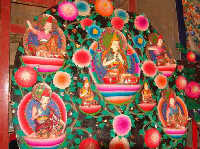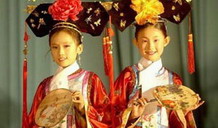Butter Sculptures
 Before sculpting, monk artists must wash and take part in a religious ritual. Then, they begin to discuss the theme of the butter sculpture. After setting the theme, they elaborate on the concept, planning, and layout of the butter sculpture. During this process, the work is distributed among the monks respectively. When all of the preparatory work is complete, the artists enter rooms at a temperature of 0℃ and begin to sculpt.
Before sculpting, monk artists must wash and take part in a religious ritual. Then, they begin to discuss the theme of the butter sculpture. After setting the theme, they elaborate on the concept, planning, and layout of the butter sculpture. During this process, the work is distributed among the monks respectively. When all of the preparatory work is complete, the artists enter rooms at a temperature of 0℃ and begin to sculpt.
The first procedure is for the artist to set up a basic frame for the butter sculpture, using some simple tools, such as soft leather, hemp rope, and hollow truncheon (Do you mean a hollow stick of some sort?).
In the next procedure, modeling, the artist employs two kinds of raw materials.
The first kind is a black mixture made from the used butter sculptures and ashes from burned wheat straw to mold different shapes on the frame. This process greatly resembles flour sculpting and clay sculpting. Then, the body must be revised and examined before the model is finally set up.
The second raw material is a mixture made from the creamy butter and many colored minerals. These are painted onto the surface of the body, and golden and silver powder is used to draw the outline of the sculpture. This process concludes the modeling of colored images.
In the last step, the butter sculptures are affixed onto several slates or a special basin as in the original design. The layout can create a flower image or a story called "frame of butter flowers."
 Contents of butter sculptures
Contents of butter sculptures
 Ways of expressing butter sculptures vary greatly, covering a wide range of contents. Mostly, they center on Buddhism, historic stories, personal biographies, birds, and beasts. Over time, they have been imbued with the various trends of each era.
Ways of expressing butter sculptures vary greatly, covering a wide range of contents. Mostly, they center on Buddhism, historic stories, personal biographies, birds, and beasts. Over time, they have been imbued with the various trends of each era.
For example, the butter sculpture "The Story About Sakyamuni" not only enriched the traditional style of butter sculpting, but also reflects real life. In this way, the former single method has evolved into a multi-method system, including a combination of stereoscopic sculptures and reliefs -- a combination of single sculptures and multi-sculptures.






